高中英语 初高中衔接课程 第二章 语音基本知识教案
- 格式:doc
- 大小:223.00 KB
- 文档页数:13
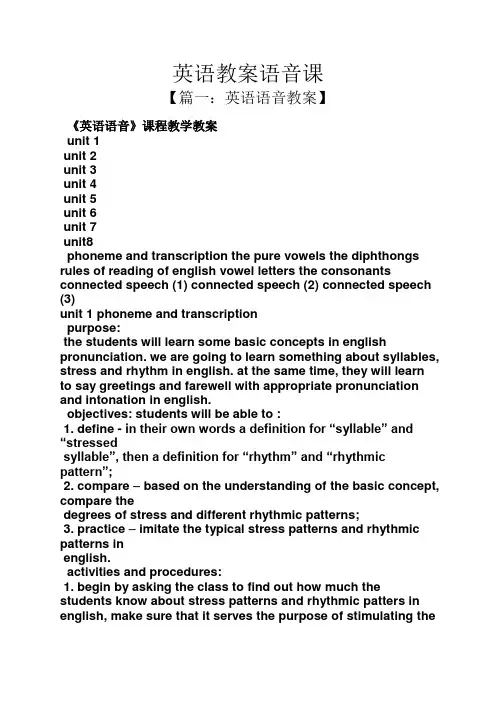
英语教案语音课【篇一:英语语音教案】《英语语音》课程教学教案unit 1unit 2unit 3unit 4unit 5unit 6unit 7unit8phoneme and transcription the pure vowels the diphthongs rules of reading of english vowel letters the consonants connected speech (1) connected speech (2) connected speech (3)unit 1 phoneme and transcriptionpurpose:the students will learn some basic concepts in english pronunciation. we are going to learn something about syllables, stress and rhythm in english. at the same time, they will learnto say greetings and farewell with appropriate pronunciation and intonation in english.objectives: students will be able to :1. define - in their own words a definition for “syllable” and “stressedsyllable”, then a definition for “rhythm” and “rhythmic pattern”;2. compare – based on the understanding of the basic concept, compare thedegrees of stress and different rhythmic patterns;3. practice – imitate the typical stress patterns and rhythmic patterns inenglish.activities and procedures:1. begin by asking the class to find out how much thestudents know about stress patterns and rhythmic patters in english, make sure that it serves the purpose of stimulating thestudents to think about the issue and have the desire to find out the answers themselves.2. display examples by playing the recording of the native speakers showing the typical stress patters and rhythmic patterns in english.3. ask the students to listen to the tapes to mark out the stressed syllables in words.4. ask the students to listen to the tapes to mark out the stressed words in sentences.5. have the students imitate the stress patterns and rhythmic patterns to experience the rhythm in speech.6. have the students share what they have learned by reading out the practice materials in pairs.7. have the students listen to the conversations recorded by native speakers of english and try to get the rhythmic patterns in their speech.8. have the students practice the guided conversation. ask them to pay special attention to the stress the rhythm in speech.9. highlight the language function in the conversation in the practice.10. have several pairs of the students present their conversation in the class.11. comment on the students? performance by highlighting the achievement of the students and the efforts they need for the improvement.12. ask the students to do more practice after class and get ready for presentation during the next session.basic concepts: syllables, stress rhythmin this unit, we are going to learn some basic concepts in english pronunciation. we are going to learn something about syllables, stress and rhythm in english. at thesame time, we are going to learn to say greetings and farewell with appropriate pronunciation and intonation in english.first of all, let?s look at the syllable in english.please listen to the following word: driveway.now, tell me, how many syllables there are in this word? right. there are two. please listen to the following sentence: drive him away.tell me, how many syllables there are in this sentence? right. there are four.introductionso. what is a syllable?a syllable is a word part and the basic unit of english rhythm. english words can have one, two, three or even more syllables. in the word ?driveway?, there are two syllables. in the sentence ?drive him away?, there are four.what is a stressed syllable?in english words with more than one syllable, one of them will receive more stress than the others. stressed syllables are those that are marked in the dictionary as stressed. for example, in the word ?driveway?, the first syllable is a stressed syllable while the second syllable is not.stressed syllables in english are usually longer, louder, and higher in pitch. listen to the following example:syllable 1 syllable 2 (short) (long)syllable 3(short)the word banana has 3 syllables. syllable 1 is not stressed and so is short. syllable 2 is stressed and so is long with a clear vowel sound / :/. syllable 3 is not stressed and so is also short. here is a short summary about the stressed and unstressed syllables:stressed syllables are strong syllables. unstressed syllables are weak syllables. stressed syllables:- are long- have a pitch change- have full vowel sounds.unstressed syllables:- are short- often have a reduced vowel sound.now let?s look at the rhythm in english.we all know that correct pronunciation of the individual english sounds is important in communication. the way the sounds are organized, however, is often more crucial for understanding. the rhythm of english, for example, is one of the two major organizing structures that native speakers rely on to process speech.what is rhythm?rhythm can be found everywhere in life: the sound of a clock, the beating of the heart, the strokes of a swimmer, and ofcourse in poetry and music. but rhythm in language is less familiar because it is less obvious. the rhythm of a language is characterized by the timing pattern of successive syllables. in some languages, every syllable is given about the same length, while in others, syllables vary in length. in english, strongbeats are called stress -- the heart of the rhythmic pattern.音节、重音与节奏本单元将向大家介绍英语语音语调的基本概念, 主要介绍英语语音的音节、重音和节奏规律。
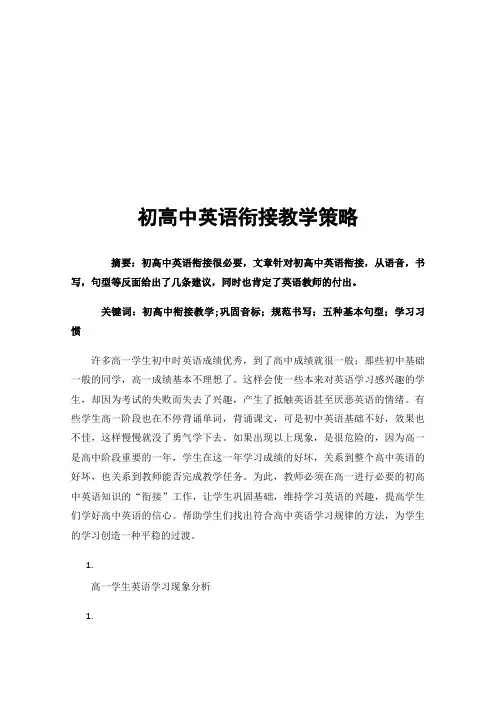
初高中英语衔接教学策略摘要:初高中英语衔接很必要,文章针对初高中英语衔接,从语音,书写,句型等反面给出了几条建议,同时也肯定了英语教师的付出。
关键词:初高中衔接教学;巩固音标;规范书写;五种基本句型;学习习惯许多高一学生初中时英语成绩优秀,到了高中成绩就很一般;那些初中基础一般的同学,高一成绩基本不理想了。
这样会使一些本来对英语学习感兴趣的学生,却因为考试的失败而失去了兴趣,产生了抵触英语甚至厌恶英语的情绪。
有些学生高一阶段也在不停背诵单词,背诵课文,可是初中英语基础不好,效果也不佳,这样慢慢就没了勇气学下去。
如果出现以上现象,是很危险的,因为高一是高中阶段重要的一年,学生在这一年学习成绩的好坏,关系到整个高中英语的好坏,也关系到教师能否完成教学任务。
为此,教师必须在高一进行必要的初高中英语知识的“衔接”工作,让学生巩固基础,维持学习英语的兴趣,提高学生们学好高中英语的信心。
帮助学生们找出符合高中英语学习规律的方法,为学生的学习创造一种平稳的过渡。
1.高一学生英语学习现象分析1.字母书写不规范近期我所任教的学生中,有极少数的学生英语书写符合要求。
很多学生尤其是部分男生字母书写笔顺颠倒,大小写字母占格不对,书写字母时没有按照“四线三格”来写,书写经常超格或没占满格,首字母大小书写不当,缺少标点或写错标点,经常把英语中的实心句号写成空心句号,单词与单词之间没有间隔,混成一片,根本无法辨认,还有同学习惯一词一点。
(二)音标不熟悉经过调查发现,部分学生初中时候老师没有教授音标或是简简单单一带而过,没有当做重点,这样会使学生们不重视音标,只是简单地跟着老师读准单词就行了,其实不然。
学会了音标,学生们会自己去读单词,发音准确接下一系列工作就好做了。
(三)学习习惯和学习态度方面通过几年高中英语教育发现,学生们英语成绩不理想原因基本包括以下几个:小学时就对英语不感兴趣;小学时学的好,初中因为某次考试或者对英语老师有偏见,最终放弃学英语;或是没有勇气突破自己,不敢去学,总认为自己不行。
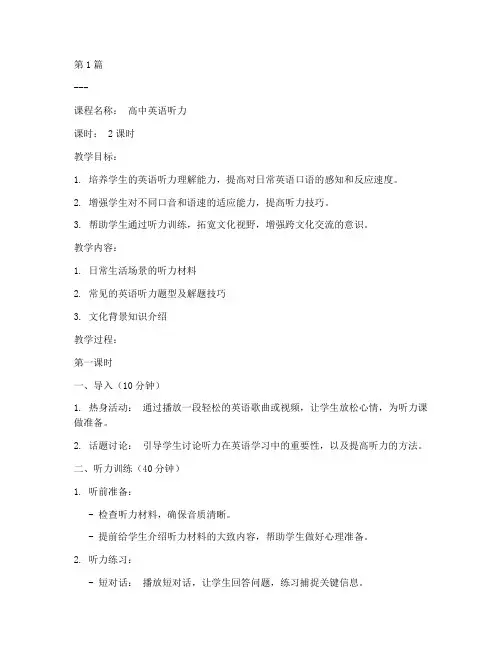
第1篇---课程名称:高中英语听力课时: 2课时教学目标:1. 培养学生的英语听力理解能力,提高对日常英语口语的感知和反应速度。
2. 增强学生对不同口音和语速的适应能力,提高听力技巧。
3. 帮助学生通过听力训练,拓宽文化视野,增强跨文化交流的意识。
教学内容:1. 日常生活场景的听力材料2. 常见的英语听力题型及解题技巧3. 文化背景知识介绍教学过程:第一课时一、导入(10分钟)1. 热身活动:通过播放一段轻松的英语歌曲或视频,让学生放松心情,为听力课做准备。
2. 话题讨论:引导学生讨论听力在英语学习中的重要性,以及提高听力的方法。
二、听力训练(40分钟)1. 听前准备:- 检查听力材料,确保音质清晰。
- 提前给学生介绍听力材料的大致内容,帮助学生做好心理准备。
2. 听力练习:- 短对话:播放短对话,让学生回答问题,练习捕捉关键信息。
- 长对话:播放长对话,让学生总结段落大意,提高对整体信息的理解能力。
- 听力理解:播放一段完整的听力材料,让学生完成相应的听力任务,如填空、选择题等。
三、听力技巧讲解(10分钟)1. 注意听力材料中的关键词和短语。
2. 学会预测和推理。
3. 提高注意力,避免分心。
四、课堂小结(5分钟)1. 回顾本节课的学习内容。
2. 鼓励学生在课后进行听力练习。
第二课时一、复习与巩固(10分钟)1. 听力游戏:通过游戏形式,让学生在轻松愉快的氛围中复习听力技巧。
2. 听力练习:播放新的听力材料,让学生进行听力练习。
二、拓展训练(40分钟)1. 文化背景知识介绍:结合听力材料,介绍相关的文化背景知识,帮助学生更好地理解听力内容。
2. 听力技巧提高:通过分析听力材料,引导学生总结提高听力水平的技巧。
三、课堂小结(5分钟)1. 总结本节课的学习内容。
2. 鼓励学生在课后继续进行听力练习。
教学反思:1. 教师应根据学生的实际情况,调整教学进度和难度。
2. 注重培养学生的听力兴趣,提高学生的参与度。
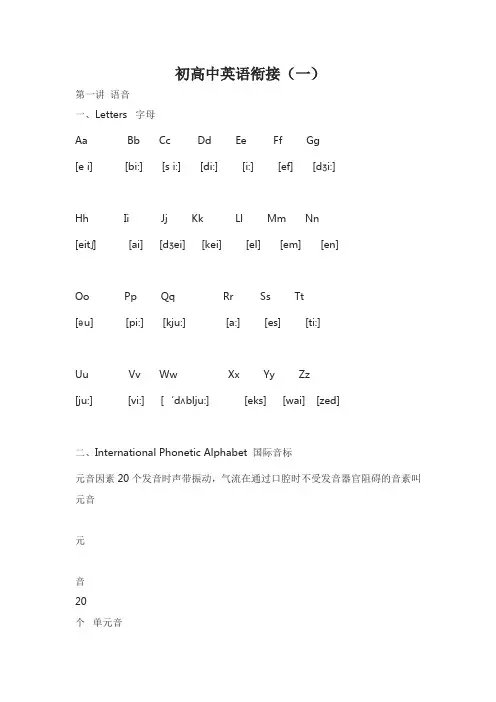
初高中英语衔接(一)第一讲语音一、Letters 字母Aa Bb Cc Dd Ee Ff Gg[e i] [bi:] [s i:] [di:] [i:] [ef] [dʒi:]Hh Ii Jj Kk Ll Mm Nn[eitʃ] [ai] [dʒei] [kei] [el] [em] [en]Oo Pp Qq Rr Ss Tt[əu] [pi:] [kju:] [a:] [es] [ti:]Uu Vv Ww Xx Yy Zz[ju:] [vi:] [‘dʌblju:] [eks] [wai] [zed]二、International Phonetic Alphabet 国际音标元音因素20个发音时声带振动,气流在通过口腔时不受发音器官阻碍的音素叫元音元音20个单元音(12个)前元音:[i:] [ i ] [e ] [æ]中元音:[ ə:] [ ə ] [ ʌ ]后元音:[ a: ] [ ɔ:] [ ɔ ] [u:] [u]双元音(8个) 合口双元音:[ei ] [ ai ] [ ɔi ] [ əu ] [ au ]集中双元音:[ iə ] [εə ] [ uə]辅音因素28个发音时气流在通过口腔时受到发音器官的阻碍而发出的音素叫辅音。
其中声带振动的叫浊辅音,声带不震动的叫清辅音轻辅音/p/ / t/ / k/ /f/ /θ/ /s/浊辅音/b/ /d/ /g/ /v/ /ð/ /z/轻辅音/ts/ /ʃ/ /tʃ/ /tr/ / h/浊辅音/dz/ /ʒ/ /dʒ/ /dr/ /r/鼻音/m/ /n/ /ŋ/半元音/w/ /j/ 舌边音/ǀ/语音的基本常识1、音节的划分一个单词的音标中有几个元音就有几个音节。
2、重读音节任何双音节或多音节单词的音标中,有重读音节和非重读音节,哪一个音节重读,该音节的左上方或该音节的元音上方标有重读符号“'”。
3、浊化音以sp__, st___, sk___开头的单词中,清辅音/p/ /t/ /k/分别要发浊辅音/b/ /d/ /g/。
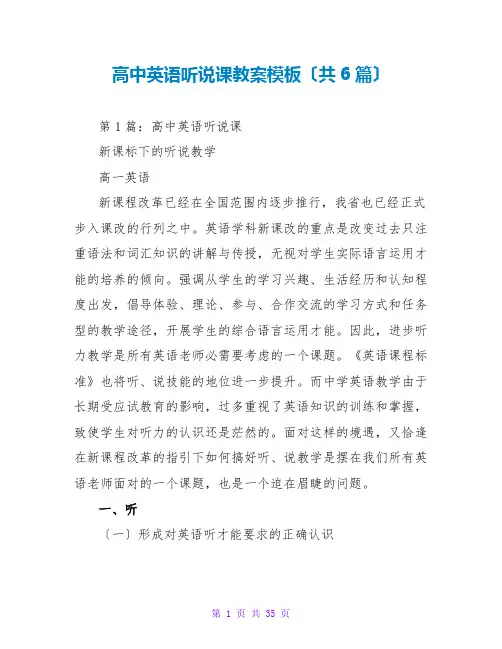
高中英语听说课教案模板〔共6篇〕第1篇:高中英语听说课新课标下的听说教学高一英语新课程改革已经在全国范围内逐步推行,我省也已经正式步入课改的行列之中。
英语学科新课改的重点是改变过去只注重语法和词汇知识的讲解与传授,无视对学生实际语言运用才能的培养的倾向。
强调从学生的学习兴趣、生活经历和认知程度出发,倡导体验、理论、参与、合作交流的学习方式和任务型的教学途径,开展学生的综合语言运用才能。
因此,进步听力教学是所有英语老师必需要考虑的一个课题。
《英语课程标准》也将听、说技能的地位进一步提升。
而中学英语教学由于长期受应试教育的影响,过多重视了英语知识的训练和掌握,致使学生对听力的认识还是茫然的。
面对这样的境遇,又恰逢在新课程改革的指引下如何搞好听、说教学是摆在我们所有英语老师面对的一个课题,也是一个迫在眉睫的问题。
一、听〔一〕形成对英语听才能要求的正确认识新课标逐年加大听力局部的分值。
目前,英语口试还不作一般考试的要求,所以,学生不会创造气氛去说英语。
基于这种情况,我们应努力让学生理解,好的听力不仅对笔试有帮助,它更是一种才能的表达,因为我们学英语的目的不是为了考试,考试是作为一种催促的手段,我们的目的是用英语来进展交际。
口头交流是最简单最普遍的交际方式。
而只有我们在听得懂别人说的话和说得出自己的观点时,我们才有交流。
所以说,听懂说好英语既是我们学习的目的,也是学习英语的根本要求。
〔二〕听前准备听前的准备工作是非常重要的,一般情况下老师只是留几分钟时间让学生自己看要答复的问题,或在多媒体课件上列出一些听力内容中的生词、词组后就让学生听了。
听完后直接对答案。
但对于那些内容较难的听力材料,我们除了做以上工作外还应该给学生讲解一些关于听力材料的背景知识,把它当作听前的热身。
可以先让学生们看问题和与它相对应的选项,在他们看完以后,我让他们猜想听力材料的大致内容。
多数同学猜不出来,少数能猜出来的同学也不敢答复。
这时可以在黑板上列出了以下一些【关键词】:^p 。
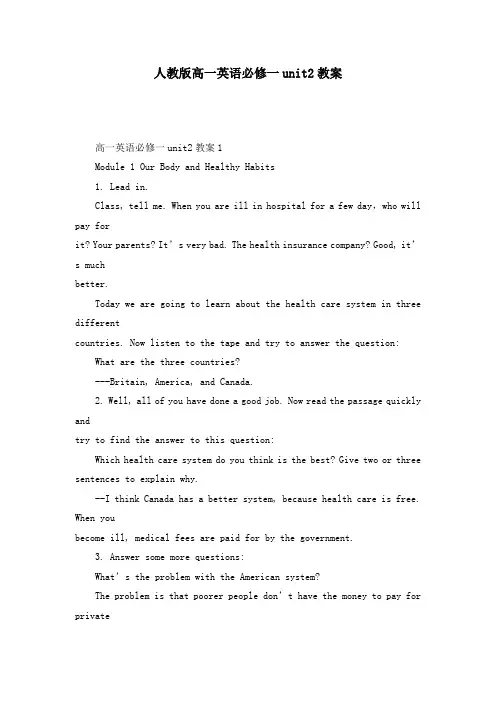
人教版高一英语必修一unit2教案高一英语必修一unit2教案1Module 1 Our Body and Healthy Habits1. Lead in.Class, tell me. When you are ill in hospital for a few day,who will pay forit? Your parents? It’s very bad. The health insurance company? Good, it’s muchbetter.Today we are going to learn about the health care system in three differentcountries. Now listen to the tape and try to answer the question:What are the three countries?---Britain, America, and Canada.2. Well, all of you have done a good job. Now read the passage quickly andtry to find the answer to this question:Which health care system do you think is the best? Give two or three sentences to explain why.--I think Canada has a better system, because health care is free. When youbecome ill, medical fees are paid for by the government.3. Answer some more questions:What’s the problem with the American system?The problem is that poorer people don’t have the money to pay for privatehealth insurance. As a result, they often have both health and money problems.Why have there been problems with the British health care system recently?This is because the government has not put enough money into the health service.What’s the result of the problems with the British health care system? More people are using private health insurance. They see doctors and thehealth insurance pay the doctors.4. Deal with some language points:1) pay for sth.pay sbpay money for sthpay sb for sth.pay off the debtspay backpay a visit topay attention to2) begin with= start withThe conference began with a song.高一英语必修一unit2教案2. I wish you were here.wish 后面跟宾语从句,从句中要用虚拟语气,即时态往前推一格, be动词改成过去式时,用 were。
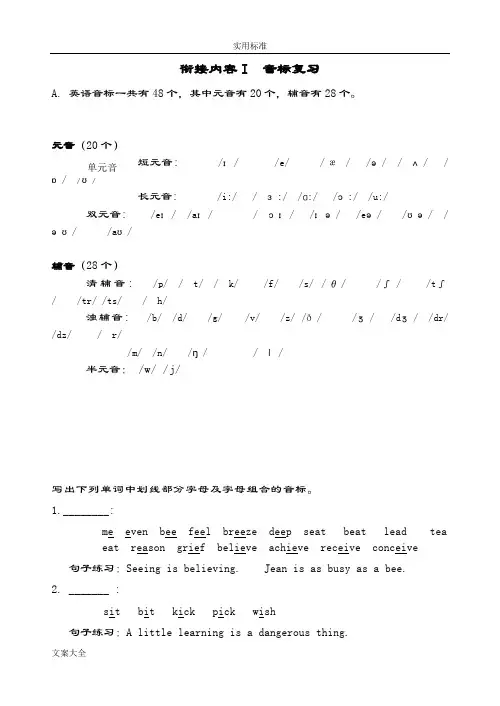
衔接内容I音标复习A.英语音标一共有48个,其中元音有20个,辅音有28个。
元音(20个)短元音: /ɪ/ /e/ / æ / /ə/ / ʌ/ /ɒ长元音: /i:/ / ɜ:/ /ɑ:/ /ɔ:/ /u:/双元音: /eɪ/ /aɪ/ / ɔɪ/ /ɪə/ /eə/ /ʊə/ /əʊ/ /aʊ/辅音(28个)清辅音: /p/ / t/ / k/ /f/ /s/ /θ/ /ʃ/ /tʃ/ /tr/ /ts/ / h/浊辅音: /b/ /d/ /g/ /v/ /z/ /ð/ /ʒ/ /dʒ/ /dr/ /dz/ / r//m/ /n/ /ŋ/ / ǀ/半元音: /w/ /j/写出下列单词中划线部分字母及字母组合的音标。
1.________:me even bee feel breeze deep seat beat lead teaeat reason grief believe achieve receive conceive 句子练习:Seeing is believing. Jean is as busy as a bee.2. _______ :sit bit kick pick wish句子练习:A little learning is a dangerous thing.His six-year old sister is as fit as a fiddle.3. ________:pen ten beg egg net bread heaven any many句子练习:Let’s get ready for the test. All’s well that ends well.4.________ :cap map bad mad bank thank lamp句子练习:Harry has a happy family in Canada.The rat is running on a narrow track.5.________:work worm bird dirt affirm term burn surf pearl learn句子练习:The German girl prefers a purple shirt to a blue one.The early bird catches the worm.6.________:appear arise again alike teacher mother brotherdriver anger doctor actor tutor famous jealous句子练习:The teachers will get together tomorrow.Do you prefer the cinema or theatre?7._______:far dark heart farm garden bar half句子练习:I like to pass through the garden park. Far from eye, far from heart.8.______:up cut but bus luck butter monk onion句子练习:Well begun is half done. Mother told the funny story just for fun.9._______:food fool cool pool shoot tomb group blue clue rule truth conclude句子练习:The news is too good to be true.That rule is useful once in a blue moon.10._______:foot good cook hook took pull full bull should句子练习:The cook cooks good food.The woman stood for as long as she could.11._______:talk ball hall door floor law saw bought foughtthought before ignore caught taught naughty forceborn sort warn句子练习:Paul’s four and can walk and talk.The storm draws near---we ought to go indoors.12.______:ox on not rot hot lot句子练习:The coffee is top quality.When the shop was robbed, everybody was shocked.13.______:eight cake fate naked snake make paid main day may句子练习:No pains, no gains. Great changes have taken place in only one day.14.______:cry dry my kite high bike tight fine time buy guy 句子练习:Time and tide wait for no man. A stitch in time saves nine.15.______:toy boy noise voice point soil coin oil句子练习:She made her point in a joyful voice.The boy was annoyed when his toy was destroyed.16.______:house sound out noun bow town now tower句子练习:How about going down south? She found out how to pronounce the sound.17.______:host nose hole note coke cope bowl know low own boat coat句子练习:The old man lives alone, but he doesn’t feel lonely.A rolling stone gathers no moss.18.______:beer deer hear near fear here句子练习:I fear we can’t hear him clearly. You are serious but sincere, my dear.19.______:hair fair air chair bear swear dare hare there句子练习:Where there’s a will, there’s a way.He rarely stares at the mayor, because he’s scared.20.______:poor lure sure tour句子练习:Surely the poor patient will be cured. The European tourist felt insecure.B. 音节:由元音和辅音构成的发音单位。
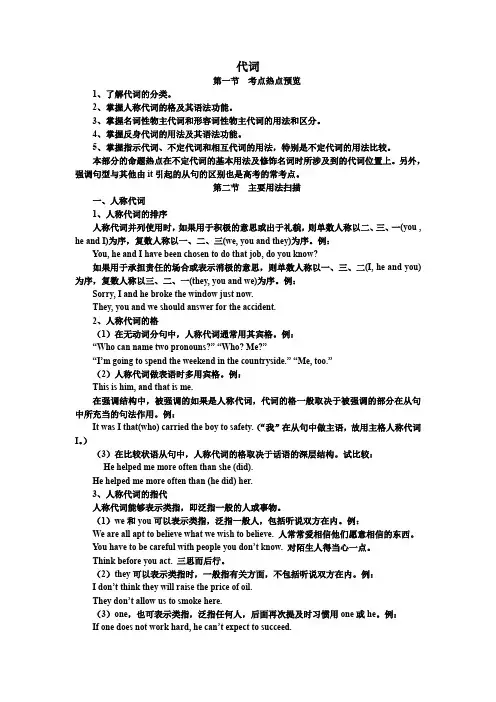
代词第一节考点热点预览1、了解代词的分类。
2、掌握人称代词的格及其语法功能。
3、掌握名词性物主代词和形容词性物主代词的用法和区分。
4、掌握反身代词的用法及其语法功能。
5、掌握指示代词、不定代词和相互代词的用法,特别是不定代词的用法比较。
本部分的命题热点在不定代词的基本用法及修饰名词时所涉及到的代词位置上。
另外,强调句型与其他由it引起的从句的区别也是高考的常考点。
第二节主要用法扫描一、人称代词1、人称代词的排序人称代词并列使用时,如果用于积极的意思或出于礼貌,则单数人称以二、三、一(you , he and I)为序,复数人称以一、二、三(we, you and they)为序。
例:You, he and I have been chosen to do that job, do you know?如果用于承担责任的场合或表示消极的意思,则单数人称以一、三、二(I, he and you)为序,复数人称以三、二、一(they, you and we)为序。
例:Sorry, I and he broke the window just now.They, you and we should answer for the accident.2、人称代词的格(1)在无动词分句中,人称代词通常用其宾格。
例:“Who can name two pronouns?” “Who? Me?”“I’m going to spend the weekend in the countryside.” “Me, too.”(2)人称代词做表语时多用宾格。
例:This is him, and that is me.在强调结构中,被强调的如果是人称代词,代词的格一般取决于被强调的部分在从句中所充当的句法作用。
例:It was I that(who) carried the boy to safety.(“我”在从句中做主语,故用主格人称代词I。

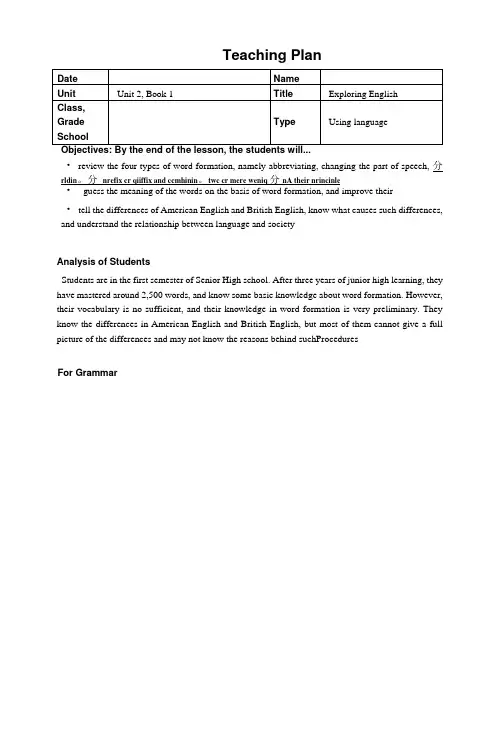
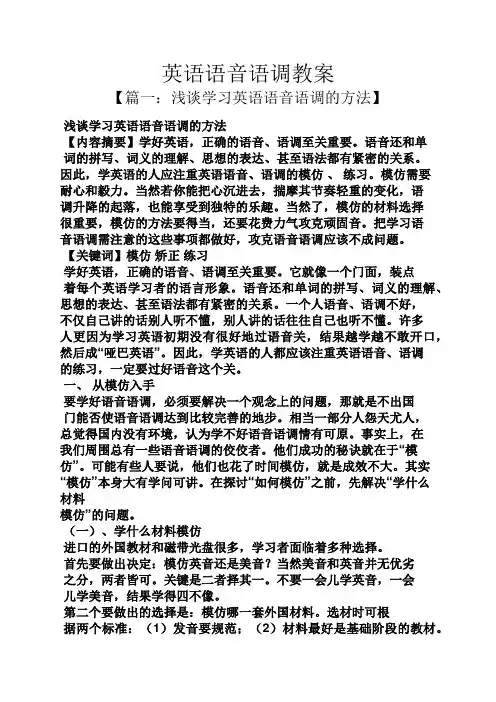
英语语音语调教案【篇一:浅谈学习英语语音语调的方法】浅谈学习英语语音语调的方法【内容摘要】学好英语,正确的语音、语调至关重要。
语音还和单词的拼写、词义的理解、思想的表达、甚至语法都有紧密的关系。
因此,学英语的人应注重英语语音、语调的模仿、练习。
模仿需要耐心和毅力。
当然若你能把心沉进去,揣摩其节奏轻重的变化,语调升降的起落,也能享受到独特的乐趣。
当然了,模仿的材料选择很重要,模仿的方法要得当,还要花费力气攻克顽固音。
把学习语音语调需注意的这些事项都做好,攻克语音语调应该不成问题。
【关键词】模仿矫正练习学好英语,正确的语音、语调至关重要。
它就像一个门面,装点着每个英语学习者的语言形象。
语音还和单词的拼写、词义的理解、思想的表达、甚至语法都有紧密的关系。
一个人语音、语调不好,不仅自己讲的话别人听不懂,别人讲的话往往自己也听不懂。
许多人更因为学习英语初期没有很好地过语音关,结果越学越不敢开口,然后成“哑巴英语”。
因此,学英语的人都应该注重英语语音、语调的练习,一定要过好语音这个关。
一、从模仿入手要学好语音语调,必须要解决一个观念上的问题,那就是不出国门能否使语音语调达到比较完善的地步。
相当一部分人怨天尤人,总觉得国内没有环境,认为学不好语音语调情有可原。
事实上,在我们周围总有一些语音语调的佼佼者。
他们成功的秘诀就在于“模仿”。
可能有些人要说,他们也花了时间模仿,就是成效不大。
其实“模仿”本身大有学问可讲。
在探讨“如何模仿”之前,先解决“学什么材料模仿”的问题。
(一)、学什么材料模仿进口的外国教材和磁带光盘很多,学习者面临着多种选择。
首先要做出决定:模仿英音还是美音?当然美音和英音并无优劣之分,两者皆可。
关键是二者择其一。
不要一会儿学英音,一会儿学美音,结果学得四不像。
第二个要做出的选择是:模仿哪一套外国材料。
选材时可根据两个标准:(1)发音要规范;(2)材料最好是基础阶段的教材。
在模仿的过程中,我们要反反复复地诵读同一材料,要读到滚瓜烂熟的地步。
《英语语音》课程教学教案Unit 1Purpose:The students will learn some basic concepts in English pronunciation. We are going to learn something about syllables, stress and rhythm in English. At the same time, they will learn to say greetings and farewell with appropriate pronunciation and intonation in English.Objectives: Students will be able to :1.Define - in their own words a definition for “syllable”and“stressed syllable”, then a definition for “rhythm” and “rhythmicpattern”;pare –based on the understanding of the basic concept,compare the degrees of stress and different rhythmic patterns;3.Practice – imitate the typical stress patterns and rhythmic patternsin English.Resources/Materials:1.Handouts: illustration of stress patterns and rhythmic pattern;2.Recordings of native speakersActivities and Procedures:1.Begin by asking the class to find out how much the students know aboutstress patterns and rhythmic patters in English, make sure that it serves the purpose of stimulating the students to think about the issue and have the desire to find out the answers themselves.2.Display examples by playing the recording of the native speakers showingthe typical stress patters and rhythmic patterns in English.3.Ask the students to listen to the tapes to mark out the stressed syllablesin words.4.Ask the students to listen to the tapes to mark out the stressed words insentences.5.Have the students imitate the stress patterns and rhythmic patterns toexperience the rhythm in speech.6.Have the students share what they have learned by reading out thepractice materials in pairs.7.Have the students listen to the conversations recorded by native speakersof English and try to get the rhythmic patterns in their speech.8.Have the students practice the guided conversation. Ask them to payspecial attention to the stress the rhythm in speech.9.Highlight the language function in the conversation in the practice.10.Have several pairs of the students present their conversation in the class.ment on the students’ performance by highlighting the achievementof the students and the efforts they need for the improvement.12.Ask the students to do more practice after class and get ready for presentationduring the next session.附: 要点、重点和难点Unit 1Basic Concepts: Syllables, Stress & RhythmIn this unit, we are going to learn some basic concepts in English pronunciation. We are going to learn something about syllables, stress and rhythm in English. At the same time, we are going to learn to say greetings and farewell with appropriate pronunciation and intonation in English.First of all, let’s look at the syllable in English.Please listen to the following word: driveway.Now, tell me, how many syllables there are in this word? Right. There are two. Please listen to the following sentence: Drive him away.Tell me, how many syllables there are in this sentence? Right. There are four.IntroductionSo. What is a syllable?A syllable is a word part and the basic unit of English rhythm. English words can have one, two, three or even more syllables. In the word ‘driveway’, there are two syllables. In the sentence ‘Drive him away’, there are four.What is a stressed syllable?In English words with more than one syllable, one of them will receive more stress than the others. Stressed syllables are those that are marked in the dictionary as stressed. For example, in the word ‘driveway’, the first syllable is a stressed syllable while the second syllable is not.Stressed syllables in English are usually longer, louder, and higher in pitch.Listen to the following example:ba NAAAA naSyllable 1 Syllable 2 Syllable 3(short) (long) (short)The word "banana" has 3 syllables. Syllable 1 is not stressed and so is short. Syllable 2 is stressed and so is long with a clear vowel sound / :/. Syllable 3 is not stressed and so is also short.Here is a short summary about the stressed and unstressed syllables: Stressed syllables are strong syllables. Unstressed syllables are weaksyllables.Stressed syllables:-are long-have a pitch change-have full vowel sounds.Unstressed syllables:-are short-often have a reduced vowel sound.Now let’s look at the rhythm in English.We all know that correct pronunciation of the individual English sounds is important in communication. The way the sounds are organized, however, is often more crucial for understanding. The rhythm of English, for example, is one of the two major organizing structures that native speakers rely on to process speech.What is rhythm?Rhythm can be found everywhere in life: the sound of a clock, the beating of the heart, the strokes of a swimmer, and of course in poetry and music. But rhythm in language is less familiar because it is less obvious. The rhythm of a language is characterized by the timing pattern of successive syllables. In some languages, every syllable is given about the same length, while in others, syllables vary in length. In English, strong beats are called stress -- theheart of the rhythmic pattern.第1单元基本概念:音节、重音与节奏本单元将向大家介绍英语语音语调的基本概念, 主要介绍英语语音的音节、重音和节奏规律。
英语语音课教学设计(范文1篇)以下是网友分享的关于英语语音课教学设计的资料1篇,希望对您有所帮助,就爱阅读感谢您的支持。
《英语语音课教学设计范文一》《英语语音》课程教学大纲学分:2学时:32先修课程:《大学英语》适用专业:非英语专业一、课程的性质和目的本课程是非英语专业本科三年级的一门专业技能课。
语音、词汇和语法是语言的三个必不可缺的组成部分,各自有独立的科学体系,却又相辅相成,互相关联,缺一不可。
语言首先是有声的,学习语音是掌握语言的基础,又是提高语言整体水平的关键。
《英语语音》是英语专业最重要的专业基础课程之一,因为语音是“将英语作为工作语言”的第一要求。
本课程的目的在于着重培养学生的英语语音实践能力,对学生进行系统、严格的英语语音技能训练。
同时向学生传授一些必要的语音基础理论知识,使学生理论联系实际,具有扎扎实实的英语语音基础知识、综合的语音技能和技巧、准确纯正的发音、流畅自然的语流语速、敏锐的辨音能力;从而帮助学生提高语言整体水平,为成为优秀的外语人才打下坚实的基础。
二、课程教学内容本课程从英语元音和辅音学习入手,进一步讲解和操练单词重音、句子重音、弱读形式和强读形式、节奏、停顿和语调。
英语44个音素中的任何一个音素都不是一成不变的,而是受到诸多因素的影响,变化繁多:因受到单词重音或句子重音的影响,或受到前后音素的影响,会发生音的长度的变化,辅音连缀、不完全爆破和连读等语音现象;因受说话人的态度和感情等因素的影响,会发生语句重音、弱读和强读、节奏、停顿、语调核心及语调变化等语音现象。
本课程要求对上述语音内容作初步的介绍,以实践为主,适当讲解有关理论,并在理论的指导下,进一步加强实践,把语音学习提到一个新的高度。
本门课程分四部分讲述。
第一部分概论(6学时)知识要点:概论部分介绍英语的元音和辅音。
通过这一部分的学习,了解学习本门课程的重要性;学习英语的发音器官图;重点理解英语元音和辅音的分类。
新课标下高中英语语音教学法介绍 【摘 要】语音是说好英语的基础。随着社会经济多元化的发展,我国与其他地区的人民接触更加密切,对话更加广泛,社会发展进步对高中英语教学有了更高的要求。高中英语是培养学生外语素质的过程,它既要满足学生自身的发展,也要建立与时俱进的教学观念,适应社会的需求,为国家培养人才。因此一口流利的、地道的英语会带你走的更远。 【关键字】新课标;高中英语;语音教学法 《高中英语新课程标准》指出高中英语应该掌握英语语言方面的基础知识,包括语音、词汇、语法、功能和话题等五方面,并且提出了相应的知识目标和功能。语音是语言交流的基础,学好英语语音有利于加深对英语语言的理解,培养学生的综合语言素质和跨文化交流的能力。教师要根据学生的身心发展特点和年龄特点,设计合适的语音教学内容和方法,指导学生正确发音,使学生形成听、说、读、写英语的习惯,提高对英语学习的兴趣。 一、新课程标准对英语语音教学的要求 高中英语课程标准改革是要努力使每一位学生都具有基本的英语语言能力基础和语言素养,习得语言基础知识和基本技能。威格尔曾经说过,在交往活动中最基本的能力是听懂别人说话的能力。英语教学要为每一位学生创设公平的语言学习平台,打好基础,满足学生的不同需要和发展。 高中英语必须进行语音教学,新《英语课程标准》指出要习得清晰、准确、流畅的口语表达,初步了解英文诗歌的韵律,根据语音识别单词的意思和听懂语言中隐含的意义。在学习英语方面,语音是否准确会影响整个学习内容,会让学生变得迷茫,失去判断力。新课程标准强调教学要从学生的实际兴趣出发,培养学生实际的综合语言运用能力,倡导师生和谐共处、开放的课堂氛围,培养学生健全的人格。 二、语音教学的难点 根据学生本身的英语水平和语音学习状况指出影响学生英语学习发展的以下几个问题。 (一)对基本的语音知识内容掌握不牢固 曲刚先生曾说过,英语音标是学生学习英语的第一道障碍。学生有没有掌握基本的语音知识和发音是否正确会影响到学生对英语的理解、阅读等方面,会使交流受阻。中学英语教学大纲也指出高中学生要掌握国际音标、语调、节奏和基本的拼读规则等语音内容,但是有些高中学生却对自己的英语发音失去信心,听不懂别人说的话,自己也张不开口、不敢说英语。在英语学习中存在着单个音素和辅音群的发音错误、单词应该重读的音节没有重读、句子通读不流畅等问题,英语老师应该根据学生的个别差异,为学生找出语音方面的问题,并且找出解决问题的教学策略。 (二)没有认识到语音学习的重要性 语音学习是英语的基础,是关键环节。英语学习往往只重视词汇、语法、阅读和写作四个方面的内容,只重视应试教育,急功近利,而忽视了打好英语学习的基础才是学好、掌握英语的关键所在,才能让英语之路走得更加顺畅。学生要明确学习动机,树立自主学习意识,掌握语音、语调会给语言交流带来便利,会提高学生的自信心,培养学生的个人素养和语言交往能力。教师要认识到语音教学的重要性,注重培养学生的发音和听力,为学生终身的英语学习打下坚实的基础。 三、英语语音教学方法及策略 (一)听、说相结合,强化语音学习 教师根据学生的英语水平提供听力材料,由浅入深,由易到难的提高学生对听力的兴趣和水平。教师在高中课堂上要强化语音训练,尽量采取英文教学的方法,创设英语学习的氛围,根据教学内容创设英语情境,感染学生,让学生主动去思考,帮助学生理解学习内容。还要采取听、说相结合的方法,不仅要让学生听英语,理解英语表达的意思,还要张开口主动地说英语,多听、多模仿,进行英语发音训练,提高英语语音水准。 (二)做好初中英语和高中英语的衔接,上好语音入门课 教师根据学生英语学习水平的实际情况,从语音入手,把握语音教学的起点,做好初高中英语的衔接工作。教师要了解学生听、说、读、写的能力,把握学生英语水平的整体状况,因材施教。教师要提高自己的英语素养,语音方面严格要求自己,最好榜样引导的作用。英语学习是一个有机的整体,包括阅读、词汇、写作、语音等几个方面的内容。在教学过程中,可以把语音教学和其他几部分联系起来,掌握发音规律,培养学生的语感。 (三)英语课堂要有趣味性,避免语言课过于单一、枯燥 英语教学方法要灵活多样,努力建设创新型课堂。高中英语内容丰富,语法知识较多,阅读材料难度相对大一点,学生容易产生厌倦心理。学生刚开始接触英语的时候,对英语有很大的兴趣和信心,想要用英语和别人交流。但随着英语知识的增多和学习难度增大,学习英语成了考试的工具而不是交流的手段,学习英语缺少灵活性,学生对英语学习没了兴趣,自然也不会学好英语。因此要建设有趣的课堂,培养学生学习英语的兴趣非常重要。教师要创设良好的学习氛围,提高学生学习语言的感染力,建设有效课堂。 (四)鼓励学生大胆说英语,提供用英语交流的机会 语言是人际交流的工具,不会说英语就使英语这门语言失去了价值。教师要鼓励学生大胆说英语,提供给学生听力材料,采用拼写、模仿、背诵等方式把握音调、重读、节奏、停顿等发音规律。也可以采用绕口令的方式提高学生的学习兴趣,把学习内容编成绕口令,使学生辨别发音的不同,练习说英语。联系实际说英语会更有情境性,让学生感受到英语的实用性。教师要指导学生主动参与实践活动,体会语言的文化差异,能够清晰的表达自己的见解。可以采用任务型教学模式,师生活动,教师可以拟定一个话题,让学生围绕这个主题运用已学的英语知识展开讨论。用英语交流,形成积极的学习态度,将英语说话渗透到平常的学习生活中,促进英语的实际运用能力。 高中英语课程体现了基础性学习、个性化学习和提高性学习的特点,在教学过程中学生有充分展示自己的机会,更加注重说英语的能力和灵活、得体的用英语交流的能力。语音教学是整个英语教学的最基础的一面,对语音的把握会直接影响到学生的英语学习,所以在进行语音教学时要根据学生的实际情况,稳扎稳打,做好系统的教学,争取从根本上解决学生的语音问题。教师在语音教学方面要以新课程标准为目标,提供给学生丰富的课程资源,建设开放的评价体系,使学生习得语言知识和语言技能,打好英语语音基础。深刻贯彻新课改的要求,培养学生的语言表达能力和英语素养。
篇一:高中英语听说课的教学设计高中英语听说课的教学设计及案例分析[1]陈小萍.巧设教学情境激活高中英语课堂--以一节听说课教学设计为例[j].中小学教学研究,2013,(11):23-26.doi:10.3969/j.issn.1674-5728.2013.11.012.(一)听和说教学内容设计1.听的教学内容设计:听力教学的内容一般应包括:⑴语音训练语音训练包括对听音、重读、意群等的训练,增强学生的语音辨别能力,对于造成听力困难的语音应专项训练。
如:bed—bad, ship—sheep, chip—cheap, pin—pen, sit—seat 训练应从词到句,再到文。
⑵听力技巧训练听力技巧包括听大意、听具体信息、猜词义、听细节、听隐含之意等。
听力教学应包含训练这些技巧的各种听力活动。
⑶听力理解训练听力技巧的培养是为理解服务的,除了语音和技巧的训练之外,听力教学更多的应是通过各种活动训练学生句子和语篇的理解能力,使学生的理解由“字面”到“隐含”再到“应用”,理解步步加深。
2.说的教学内容设计:说的教学内容一般应包括:⑴发音错误的发音会造成理解困难,甚至使听者无法理解,因此说的教学内容首先应是正确的发音,包括音节、重读、弱读、连读、送气减弱、意群、停顿、语调等。
⑵语法、词汇合乎语法的句子才容易理解,用词准确,有助于理解。
缺乏必要的词汇常使说话者难以准确地表达自己的思想。
因此说的教学应包含一定的词汇和语法教学。
⑶交际功能通过说的教学,学生应能掌握“问候”“道歉”“抱怨”“邀请”“建议”“致谢”“信息询问”“征求意见”等各种交际功能。
⑷释疑技巧mean...?”要求对方解释自己说过的话可以用升调重复对方的话,等等。
⑸文化知识交际不仅依赖于语言的准确性,同样依赖于语言的得体性。
这就要求,说话者有必要了解一定的文化知识,使自己的语言符合其所适用的文化氛围,符合其所处的语言环境,符合其所担任的角色。
(二)听说课的教学模式为了更好地上好听说课,我们要掌握听说课的要领:1) 听前:准备要充分,教师提前预设问题,为听力教学作好充分的铺垫。
第二章 语音基本知识 一、26个英文字母及发音音标 A a [eI] B b [bi:] C c [si:] D d [di:] E e [i:] F f [ef] G g [dʒi:] H h [eItʃ] I i [aI] J j [dʒeI] K k [keI] L l [el] M m [em] N n [en] O o [əʊ] P p [pi:] Q q [kju:] R r [ɑ:] S s [es] T t [ti:] U u [ju:] V v [vi:] W w [′d∧blju:] X x [eks] Y y [waI] Z z [zi:][zed] 从以上我们可以看出,英语字母中有一些含有共同的元音音素,比如: 1)含元音音素[eI] 字母: Aa Hh Jj Kk 音标: [eI] [eItʃ] [dʒeI] [keI] 2)含元音音素[i:] 字母: Bb Cc Dd Ee Gg Pp Tt Vv 音标: [bi:] [si:] [di:] [i:] [dʒi:] [pi:] [ti:] [vi:] 3)含元音音素[e] 字母: Ff Ll Mm Nn Ss Xx Zz 音标: [ef] [el] [em] [en] [es] [eks] [zed] 4)含元音音素[ju:] 字母: Uu Qq Ww 音标: [ju:] [kju:] [`d∧blju:] 5) 含元音音素[aI] 字母: Ii Yy 音标: [aI] [waI] 二、英语音标 英语音标一共有48个,具体如下: 元音 12个单元音 长元音 [i:] [З:] [ɔ:] [u:] [ɑ:] 短元音 [e] [ɒ] [ʊ] [ə] [І] [æ] [Λ] 8个双元音 [aI] [eI] [ɔI] [əʊ] [Iə] [eə] [ʊə] [aʊ] 辅音 10对 清辅音 [p] [t] [k] [f] [s] [θ] [∫] [tʃ] [tr] [ts] 浊辅音 [b] [d] [g] [v] [z] [ð] [ʒ] [dʒ] [dr] [dz] [m] [n] [ŋ] 3个似拼音 [h] [r] [l] 2个半元音 [w] [j] 新旧英语国际音标对照表 最近几年,英语新教材中,逐渐使用了新式音标。本图表列出了英语中所有的新、旧音标,以便更好地学习和了解国际音标的变化。
三、英语口腔发音图 Vowels 元音
新 i: І e æ З: ə Λ u: ʊ ɔ: 旧 i: i e æ ə: ə Λ u: u ɔ: 新 ɒ ɑ: eI aI ɔI əʊ aʊ Iə eə ʊə 旧 ɔ ɑ: ei ai ɔi əu au iə εə uə
Consonants 辅音 无变化 p b t d k g f v s z θ ð m n ŋ l r h w j
∫ ʒ t∫ dʒ tr dr ts dz 1、上唇(upper lip) 2、下唇(lower lip) 3、上齿(upper teeth) 4、下齿(lower teeth) 5、齿龈(alveolar ridge) 6、硬腭(hard palate) 7、软腭(soft palate) 8、小舌(uvula) 9、舌尖(tip of the tongue) 10、舌前部(front of the tongue) 11、舌后部(back of the tongue) 12、喉头(larynx) 13、声带(vocal cords) 14、气管(trachea) 15、咽腔(pharynx) 16、口腔(oral cavity) 17、鼻腔(nasal cavity) 四、48个英语国际音标发音规则及练习 元音 1、前元音[i:] [І] [e] [æ] 所谓前元音是指发音时要使用舌前部,也就是说舌前部要向硬腭抬起,舌尖要抵住下齿,口形扁平,不要收圆。四个前元音中发[i:]的时候舌前部抬得最高,牙床近乎全合。发[І]的时候舌前部比[i:]稍低,牙床也开得稍大一些。上下齿之间的距离大约可以容纳一个小指尖。发第三个前元音[e]的时候舌前部比[І]又要第一些,牙床也开得更大一些。上下齿之间的距离大约相当于一个食指尖。发第四个前元音[æ]的时候舌前部最低,牙床开得最大。上下齿之间的距离大约相当于一个食指加中指。 [i:] me he she these Chinese meet [І] sit six is it this milk [e] desk pen bed egg red [æ] bag map apple cat hand 2、后元音[ɑ:] [Λ] [ɔ:] [ʊ] [u:] [ɒ] 所谓后元音是指发音时要使用舌的后部,也就是说舌后部要向软腭抬起。发后元音时舌尖可以不抵下齿。除了后元音[ɑ:]要用中常唇外,其它四个音都要用圆唇,发音时嘴要拢圆。个别的音如[ʊ] [u:]嘴唇还要向前突出。其次,要注意后元音的舌位。五个后元音中[ɑ:]的舌位最低,开口最大。[Λ]的舌位比[ɑ:]稍高,开口度比[ɑ:]稍小。[ɔ:]的舌位比[Λ]又要更高一些。[ʊ]的舌位比[ɔ:]又要高一些,开口度再小一些。[u:]的舌位最高,开口最小。发[ɒ]音时,要注意双唇收圆,不然容易发成[ɑ:],所以学习这个音时可以先发[ɑ:],然后将双唇收圆,就会发出[ɒ]音。 [ɑ:] part half ask class father [Λ] cut love touch bus come [ɔ:] sort door saw talk four [ʊ] put book woman look could [u:] do zoo blue ruler move [ɒ] top cock box what want 3、中元音[З:] [ə] 所谓中元音是指发音时要使用舌的中部,也就是说舌的中部要稍稍抬起,舌尖可以轻抵下齿,口形扁平或中常。[З:]的舌位比 [ə]稍高。 [З:] bird serve term work turn [ə] about China letter actor again 上面提到了12个单元音。英语里还有8个双元音。这8个双元音又可分成两类,合口 双元音和集中双元音,下面分别讲解。 4、合口双元音[eI] [aI] [ɔI] [əʊ] [aʊ] 所谓“合口双元音”是指两个元音中的第二个元音都是一个合口元音[І]或[ʊ]。发双元音时要注意从第一个元音向第二个元音滑动。在滑动过程中,口形、舌位都有明显的变化。另外,还要注意双元音的下面几个特点: 1)、前长后短(前音长后音短)。2)、前重后轻(前音发得重,后音发得轻)。3)、前音清楚,后音模糊。 [eI] cake plane snake table baby [aI] bike life light type nice [ɔI] toy voice coin enjoy boy [əʊ] go boat hope know home [aʊ] now how loud house out 5、集中双元音[Iə] [eə] [ʊə] 所谓集中双元音是指两个元音中的第二个元音都是中元音[ə]。发音时要注意第一个元音向第二个元音滑动时的口形和舌位的变化。比如发[Iə]时舌位由前元音[I]向中元音[ə]的滑动。口形由半合的扁唇变为稍高于半开的扁唇。发[eə]时由相当于前元音[e]的舌位向中元音[ə]滑动,口形由半开的中常唇变为稍高于半开的扁唇。发[ʊə]时由后元音[ʊ]向中元音[ə]的滑动,口形由半合的圆唇变为稍高于半开的扁唇。 [Iə] fear beer ear hear deer [eə] care bear fair where chair [ʊə] sure tour poor moor cure 辅音 1、爆破音 爆破音一共有六个,根据发音时声带是否振动可以分为清辅音和浊辅音两种。清辅音有三个:[p],[t],[k];浊辅音也有三个:[b],[d],[g]。这样,六个爆破音就可以归纳为清、浊相对应的三对。第一对是:[p],第二对是:[t],[d],第三对是[k],[g] [p],双唇音,发音时,双唇紧闭,气流从口腔冲出,送气有力;清音,发音时不震动声带。 pen map top pipe cup [b],双唇音,发音时,双唇紧闭,气流从口腔冲出,送气有力;但 它在词尾时发得很轻,不如[p]送气有力;浊音,发音时震动声带。 bee beep about lab bat [t],齿槽音,发音时,舌端抵齿槽,气流从口腔冲出,送气有力;清音。 butter that fat debt dealer [d],齿槽音,发 音时,舌端抵齿槽,气流从口腔冲出,但在词尾时发得很轻,不如[t]送气有力;浊音。 desk food deep door dot [k],后舌音,发音时,后舌隆起,气流从喉咙口用力冲出,送气有力;清音,发音时不振动声带。 cook book kick bucket tick [g],后舌音,发音时,后舌隆起,气流从喉咙口用力冲出,送气有力;但在词尾时发得很轻,不如 [k]送气有力;浊音,发音时振动声带。 get game good dog tag